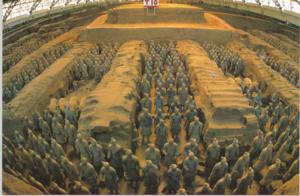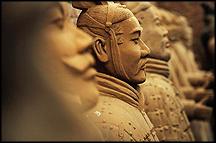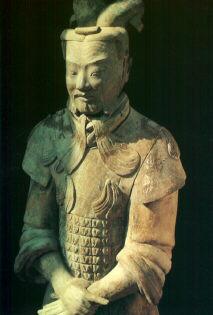
The Ch'in tomb, built during a 36 year period between 256 BC and 206 BC.

The tomb of emperor Shi huang-ti is one of the wonders of the world. Its design and size can only be understood as an outcome of the emperor's obsession with eternal life.
 The tomb is believed to be an immense complex. Covered up by Shi huang-ti's successor, it was rediscovered in 1974, when a workers' brigade drilling a well discovered an underground chamber. As it turned out, the chamber contains over 6000 life-size terra-cotta figures of soldiers and horses. Each figure is individually formed, and not two are alike. The figures carry real weapons, ride in chariots and bring along valuable objects of silk, linen and other materials. Some believe that they are portraits of the emperor's army.
The tomb is believed to be an immense complex. Covered up by Shi huang-ti's successor, it was rediscovered in 1974, when a workers' brigade drilling a well discovered an underground chamber. As it turned out, the chamber contains over 6000 life-size terra-cotta figures of soldiers and horses. Each figure is individually formed, and not two are alike. The figures carry real weapons, ride in chariots and bring along valuable objects of silk, linen and other materials. Some believe that they are portraits of the emperor's army.
The main tomb has not been excavated yet. It is believed to be a vast underground palace and still intact. 700,000 labourers were conscribed to build it over a period of more than 36 years. Ssu-ma Ch'ien, a historian who lived about 50 years after the tomb's construction (c. 145 - c. 85 BC) described it thus:
 "The labourers dug through three subterranean streams, which they sealed off with bronze to construct the burial chamber. They built models of palaces, pavilions and offices and filled the tomb with fine vessels, precious stones and rarities. Artisans were ordered to install mechanically triggered crossbows set to shoot any intruder. With quicksilver the various waterways of the empire, the Yangtse and Yellow Rivers, and even the great ocean itself were created and made to flow and circulate mechanically. With shining pearls the heavenly constellations were depicted above, and with figures of birds in gold and silver and of pine trees carved of jade the earth was laid out below. Lamps were fuelled with whale oil so that they might burn forever."
"The labourers dug through three subterranean streams, which they sealed off with bronze to construct the burial chamber. They built models of palaces, pavilions and offices and filled the tomb with fine vessels, precious stones and rarities. Artisans were ordered to install mechanically triggered crossbows set to shoot any intruder. With quicksilver the various waterways of the empire, the Yangtse and Yellow Rivers, and even the great ocean itself were created and made to flow and circulate mechanically. With shining pearls the heavenly constellations were depicted above, and with figures of birds in gold and silver and of pine trees carved of jade the earth was laid out below. Lamps were fuelled with whale oil so that they might burn forever."